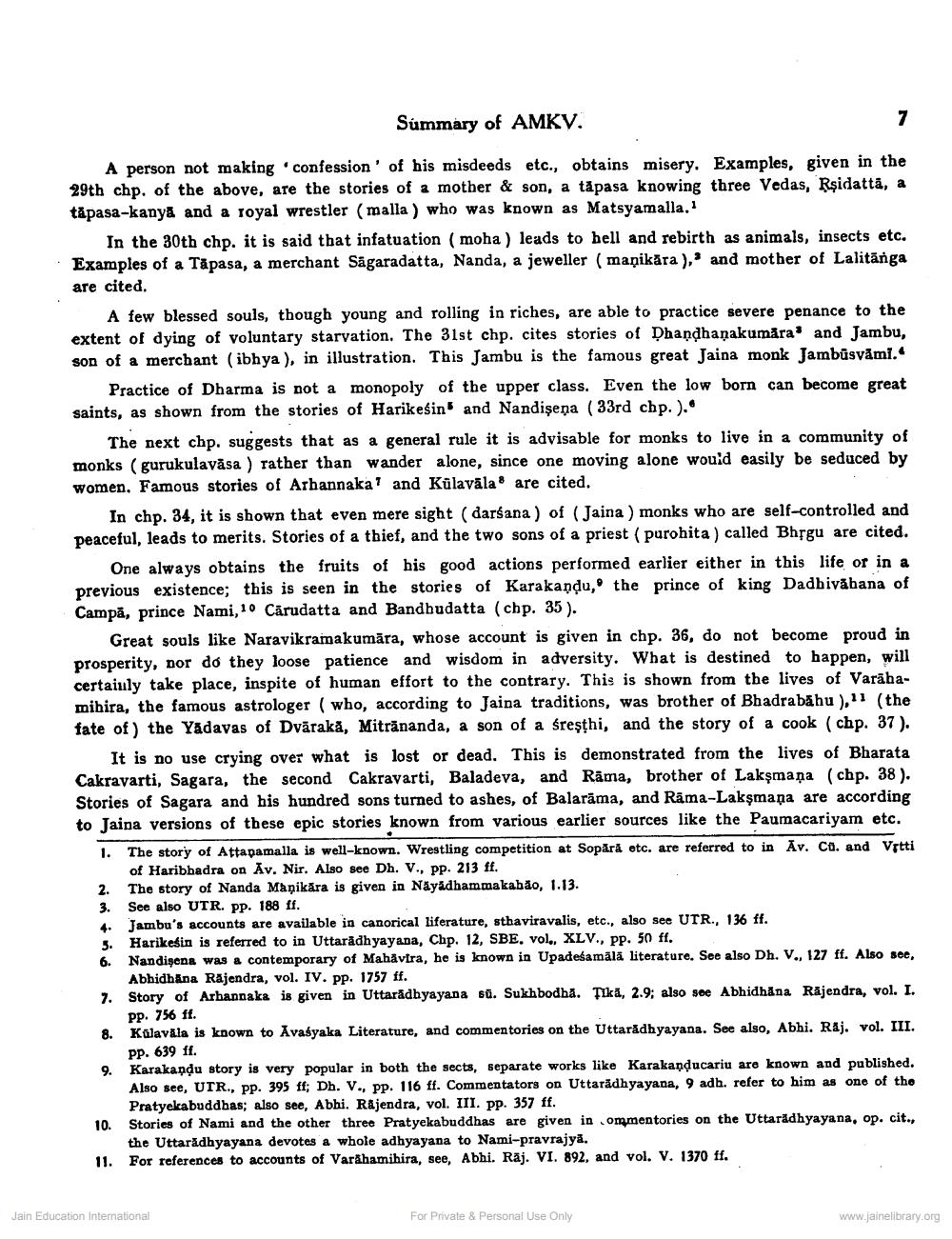________________
Summary of AMKV.
A person not making confession of his misdeeds etc., obtains misery. Examples, given in the 29th chp. of the above, are the stories of a mother & son, a tåpasa knowing three Vedas, Rşidatta, a tåpasa-kanya and a royal wrestler (malla ) who was known as Matsyamalla.
In the 30th chp, it is said that infatuation ( moha ) leads to hell and rebirth as animals, insects etc. Examples of a Tāpasa, a merchant Sagaradatta, Nanda, a jeweller (maņikāra ),' and mother of Lalitānga are cited.
A few blessed souls, though young and rolling in riches, are able to practice severe penance to the extent of dying of voluntary starvation. The 31st chp. cites stories of Dhandhanakumara' and Jambu, son of a merchant (ibhya ), in illustration. This Jambu is the famous great Jaina monk Jambūsvåmi.
Practice of Dharma is not a monopoly of the upper class. Even the low born can become great saints, as shown from the stories of Harikesin and Nandişeņa ( 33rd chp.).
The next chp. suggests that as a general rule it is advisable for monks to live in a community of monks (gurukulavāsa ) rather than wander alone, since one moving alone would easily be seduced by women. Famous stories of Arhannaka' and Külavāla are cited.
In chp. 34, it is shown that even mere sight (darśana ) of (Jaina ) monks who are self-controlled and peaceful, leads to merits. Stories of a thief, and the two sons of a priest (purohita) called Bhrgu are cited.
One always obtains the fruits of his good actions performed earlier either in this life or in a previous existence; this is seen in the stories of Karakandu, the prince of king Dadbivăbana of Campă, prince Nami, 1. Cărudatta and Bandhudatta (chp. 35).
Great souls like Naravikramakumāra, whose account is given in chp. 36, do not become proud in prosperity, nor do they loose patience and wisdom in adversity. What is destined to happen, will certaiuly take place, inspite of human effort to the contrary. This is shown from the lives of Varahamihira, the famous astrologer (who, according to Jaina traditions, was brother of Bhadrabahu ),11 (the fate of the Yadavas of Dvāraka, Mitrānanda, a son of a śreşthi, and the story of a cook (chp. 37).
It is no use crying over what is lost or dead. This is demonstrated from the lives of Bharata Cakravarti, Sagara, the second Cakravarti, Baladeva, and Rāma, brother of Lakşmaņa (chp. 38). Stories of Sagara and his hundred sons turned to ashes, of Balarama, and Rāma-Lakşmaņa are according to Jaina versions of these epic stories known from various earlier sources like the Paumacariyam etc. 1. The story of Attapamalla is well-known. Wrestling competition at Sopără etc. are referred to in Av. Co. and Vștti
of Haribhadra on Av. Nir. Also see Dh. V., pp. 213 ff. 2. The story of Nanda Maņikära is given in Näyādhammakabão, 1.13.
See also UTR. PP. 188 ff. Jambu's accounts are available in canorical liferature, sthaviravalis, etc., also see UTR., 136 ff. Harikesin is referred to in Uttaradhyayana, Chp. 12, SBE, vol., XLV., pp. 50 ff. Nandişens was a contemporary of Mahavira, he is known in Upadeśamāla literature. See also Dh. V., 127 ff. Also see,
Abhidhāna Rajendra, vol. IV. pp. 1757 ff. 7. Story of Arhannaka is given in Uttaradhyayana sū. Sukhbodha. Tika, 2.9; also see Abhidhāna Rajendra, vol. I.
pp. 756 ff. Kalavala is known to Avasyaka Literature, and commentories on the Uttaradhyayana. See also, Abhi. Raj. vol. III. PP. 639 ff. Karakandu story is very popular in both the sects, separate works like Karakanducariu are known and published. Also see, UTR., PP. 395 ff; Dh. V., pp. 116 ff. Commentators on Uttaradhyayana, 9 adh. refer to him as one of the Pratyekabuddhas; also see, Abhi. Rajendra, vol. III. PP. 357 ff. Stories of Nami and the other three Pratyekabuddhas are given in ommentories on the Uttaradhyayana, op. cit.,
the Uttarădhyayana devotes a whole adhyayana to Nami-pravrajya. 11. For references to accounts of Varahamihira, see, Abhi. Raj. VI. 892, and vol. V. 1370 ff.
9.
Jain Education Interational
For Private & Personal Use Only
www.jainelibrary.org




